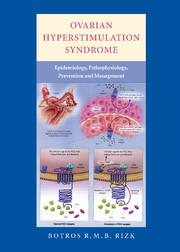Book contents
- Frontmatter
- Contents
- Foreword by Robert G. Edwards
- Preface
- I Classification of Ovarian Hyperstimulation Syndrome
- II Epidemiology of Ovarian Hyperstimulation Syndrome: Iatrogenic and Spontaneous
- III Pathophysiology of Ovarian Hyperstimulation Syndrome
- IV Genetics of Ovarian Hyperstimulation Syndrome
- V Complications of Ovarian Hyperstimulation Syndrome
- VI Prediction of Ovarian Hyperstimulation Syndrome
- VII Prevention of Ovarian Hyperstimulation Syndrome
- VIII Treatment of Ovarian Hyperstimulation Syndrome
- Index
- Plate section
- References
III - Pathophysiology of Ovarian Hyperstimulation Syndrome
Published online by Cambridge University Press: 11 August 2009
- Frontmatter
- Contents
- Foreword by Robert G. Edwards
- Preface
- I Classification of Ovarian Hyperstimulation Syndrome
- II Epidemiology of Ovarian Hyperstimulation Syndrome: Iatrogenic and Spontaneous
- III Pathophysiology of Ovarian Hyperstimulation Syndrome
- IV Genetics of Ovarian Hyperstimulation Syndrome
- V Complications of Ovarian Hyperstimulation Syndrome
- VI Prediction of Ovarian Hyperstimulation Syndrome
- VII Prevention of Ovarian Hyperstimulation Syndrome
- VIII Treatment of Ovarian Hyperstimulation Syndrome
- Index
- Plate section
- References
Summary
Rizk et al. (1997) have extensively reviewed the pathophysiology of OHSS. OHSS is marked by massive bilateral cystic ovarian enlargement (Figure I.1). The ovaries are noted to have a significant degree of stromal edema, interspersed with multiple hemorrhagic follicular and theca-lutein cysts, areas of cortical necrosis and neovascularization. The second pathological phenomenon is that of acute body fluid shifts, resulting in ascites (Figure I.2) and pleural effusion. Most investigators believe that these fluid shifts are the result of enhanced capillary permeability (Rizk and Aboulghar, 1991, 1999; El-Chalal and Schenker, 1997; Kaiser, 2003). This has been demonstrated in several animal models including hyperstimulated rats (Gomez et al., 2002), and rabbits (Schenker and Weinstein, 1978). More recently, Tollan et al. (1990) showed that, during ovarian stimulation for IVF, there is infiltration of fluid from the vascular space to the interstitial compartment one day before oocyte aspiration. Significant advances have been made in our understanding of the nature of the vasoactive agents involved (Figure III.1).
ROLE OF PERIPHERAL ARTERIOLAR DILATATION
In contrast to our classic concept of increased capillary permeability (Rizk, 1993a, b; Aboulghar et al., 1996; Rizk et al., 1997). Balasch et al. (1991) adopted a very different and interesting view. They studied the hemodynamic changes in severe OHSS and suggested that the circulatory disturbances are not secondary to reduction in circulating blood volume, but are a consequence of an intense peripheral arteriolar vasodilatation that leads to underfilling of the arterial vascular component, arterial hypotension and a compensatory increase in heart rate and cardiac output (Balasch et al., 1991).
- Type
- Chapter
- Information
- Ovarian Hyperstimulation SyndromeEpidemiology, Pathophysiology, Prevention and Management, pp. 43 - 78Publisher: Cambridge University PressPrint publication year: 2006

